万圣节的习俗(中英文版)
- 格式:doc
- 大小:22.50 KB
- 文档页数:2
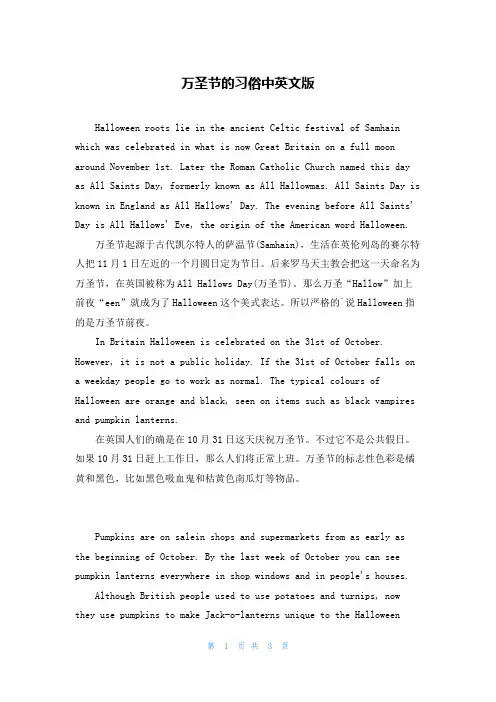
万圣节的习俗中英文版Halloween roots lie in the ancient Celtic festival of Samhain which was celebrated in what is now Great Britain on a full moon around November 1st. Later the Roman Catholic Church named this day as All Saints Day, formerly known as All Hallowmas. All Saints Day is known in England as All Hallows' Day. The evening before All Saints' Day is All Hallows' Eve, the origin of the American word Halloween.万圣节起源于古代凯尔特人的萨温节(Samhain),生活在英伦列岛的赛尔特人把11月1日左近的一个月圆日定为节日。
后来罗马天主教会把这一天命名为万圣节,在英国被称为All Hallows Day(万圣节)。
那么万圣“Hallow”加上前夜“een”就成为了Halloween这个美式表达。
所以严格的`说Halloween指的是万圣节前夜。
In Britain Halloween is celebrated on the 31st of October. However, it is not a public holiday. If the 31st of October falls on a weekday people go to work as normal. The typical colours of Halloween are orange and black, seen on items such as black vampires and pumpkin lanterns.在英国人们的确是在10月31日这天庆祝万圣节。
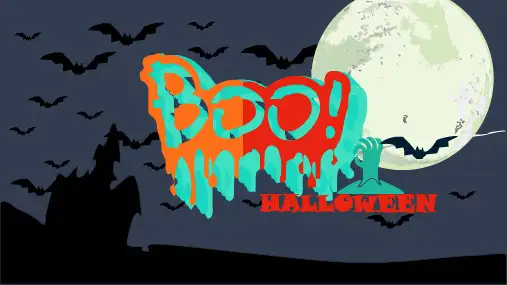
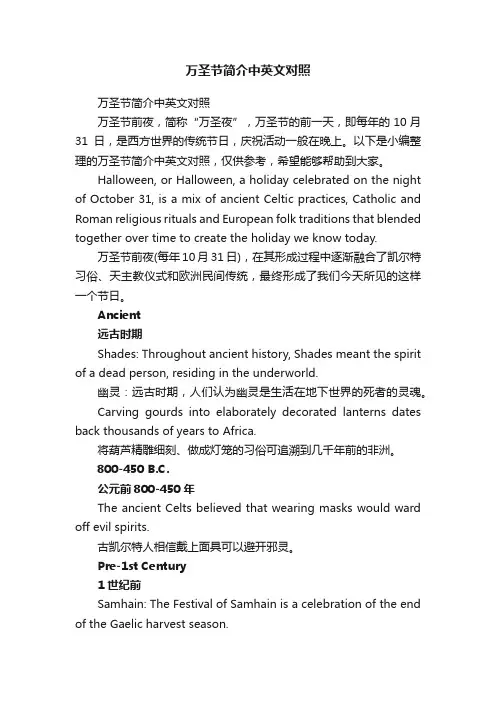
万圣节简介中英文对照万圣节简介中英文对照万圣节前夜,简称“万圣夜”,万圣节的前一天,即每年的10月31日,是西方世界的传统节日,庆祝活动一般在晚上。
以下是小编整理的万圣节简介中英文对照,仅供参考,希望能够帮助到大家。
Halloween, or Halloween, a holiday celebrated on the night of October 31, is a mix of ancient Celtic practices, Catholic and Roman religious rituals and European folk traditions that blended together over time to create the holiday we know today.万圣节前夜(每年10月31日),在其形成过程中逐渐融合了凯尔特习俗、天主教仪式和欧洲民间传统,最终形成了我们今天所见的这样一个节日。
Ancient远古时期Shades: Throughout ancient history, Shades meant the spirit of a dead person, residing in the underworld.幽灵:远古时期,人们认为幽灵是生活在地下世界的死者的灵魂。
Carving gourds into elaborately decorated lanterns dates back thousands of years to Africa.将葫芦精雕细刻、做成灯笼的习俗可追溯到几千年前的非洲。
800-450 B.C.公元前800-450年The ancient Celts believed that wearing masks would ward off evil spirits.古凯尔特人相信戴上面具可以避开邪灵。
Pre-1st Century1世纪前Samhain: The Festival of Samhain is a celebration of the end of the Gaelic harvest season.死神节:盖尔人(苏格兰和爱尔兰的凯尔特人)庆祝丰收季节结束的节日。
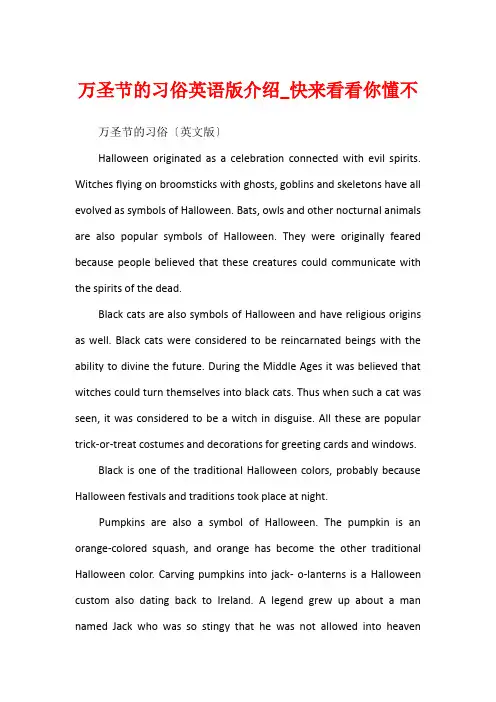
万圣节的习俗英语版介绍_快来看看你懂不万圣节的习俗〔英文版〕Halloween originated as a celebration connected with evil spirits. Witches flying on broomsticks with ghosts, goblins and skeletons have all evolved as symbols of Halloween. Bats, owls and other nocturnal animals are also popular symbols of Halloween. They were originally feared because people believed that these creatures could communicate with the spirits of the dead.Black cats are also symbols of Halloween and have religious origins as well. Black cats were considered to be reincarnated beings with the ability to divine the future. During the Middle Ages it was believed that witches could turn themselves into black cats. Thus when such a cat was seen, it was considered to be a witch in disguise. All these are popular trick-or-treat costumes and decorations for greeting cards and windows.Black is one of the traditional Halloween colors, probably because Halloween festivals and traditions took place at night.Pumpkins are also a symbol of Halloween. The pumpkin is an orange-colored squash, and orange has become the other traditional Halloween color. Carving pumpkins into jack- o-lanterns is a Halloween custom also dating back to Ireland. A legend grew up about a man named Jack who was so stingy that he was not allowed into heavenwhen he died, because he was a miser. He couldnt enter hell either because he had played jokes on the devil. As a result, Jack had to walk on the earth with his lantern until Judgement Day. So Jack and his lantern became the symbol of a lost or damned soul. To scare these souls away on Halloween, the Irish people carved scary faces out of turnips, beets or potatoes representing Jack of the Lantern, or Jack-o-lantern. When the Irish brought their customs to the United States, they carved faces on pumpkins because in the autumn they were more plentiful than turnips. Today jack-o-lanterns in the windows of a house on Halloween night let costumed children know that there are goodies waiting if they knock and say Trick or Treat!万圣节的习俗参考译文万圣节前夜起源于与邪恶幽灵相关的庆祝活动,所以骑着扫帚的女巫、幽灵、小妖精和骷髅都是万圣节的标记物。
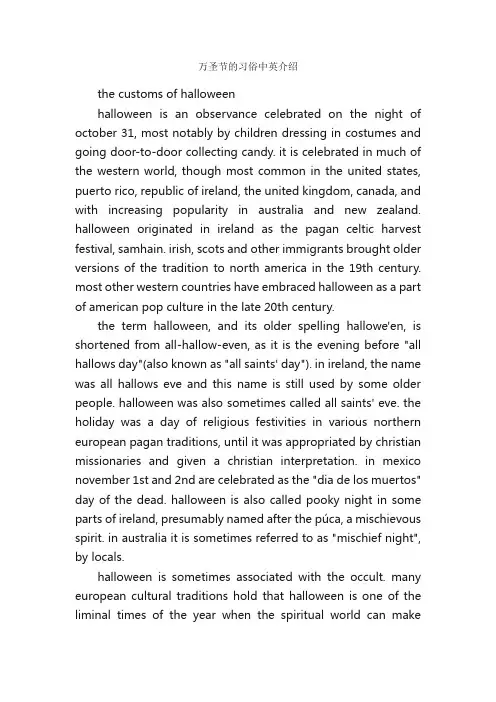
万圣节的习俗中英介绍the customs of halloweenhalloween is an observance celebrated on the night of october 31, most notably by children dressing in costumes and going door-to-door collecting candy. it is celebrated in much of the western world, though most common in the united states, puerto rico, republic of ireland, the united kingdom, canada, and with increasing popularity in australia and new zealand. halloween originated in ireland as the pagan celtic harvest festival, samhain. irish, scots and other immigrants brought older versions of the tradition to north america in the 19th century. most other western countries have embraced halloween as a part of american pop culture in the late 20th century.the term halloween, and its older spelling hallowe'en, is shortened from all-hallow-even, as it is the evening before "all hallows day"(also known as "all saints' day"). in ireland, the name was all hallows eve and this name is still used by some older people. halloween was also sometimes called all saints' eve. the holiday was a day of religious festivities in various northern european pagan traditions, until it was appropriated by christian missionaries and given a christian interpretation. in mexico november 1st and 2nd are celebrated as the "dia de los muertos" day of the dead. halloween is also called pooky night in some parts of ireland, presumably named after the púca, a mischievous spirit. in australia it is sometimes referred to as "mischief night", by locals.halloween is sometimes associated with the occult. many european cultural traditions hold that halloween is one of the liminal times of the year when the spiritual world can makecontact with the physical world and when magic is most potent (e.g. catalan mythology about witches).halloween is an annual celebration, but just what is it actually a celebration of? and how did this peculiar custom originate? is it, as some claim, a kind of demon worship? or is it just a harmless vestige of some ancient pagan ritual?the word itself, "halloween," actually has its origins in the catholic church. it comes from a contracted corruption of all hallows eve. november 1, "all hollows day" (or "all saints day"), is a catholic day of observance in honor of saints. but, in the 5th century bc, in celtic ireland, summer officially ended on october 31. the holiday was called samhain (sow-en), the celtic new year.one story says that, on that day, the disembodied spirits of all those who had died throughout the preceding year would come back in search of living bodies to possess for the next year. it was believed to be their only hope for the afterlife. the celts believed all laws of space and time were suspended during this time, allowing the spirit world to intermingle with the living.naturally, the still-living did not want to be possessed. so on the night of october 31, villagers would extinguish the fires in their homes, to make them cold and undesirable. they would then dress up in all manner of ghoulish costumes and noisily paraded around the neighborhood, being as destructive as possible in order to frighten away spirits looking for bodies to possess.probably a better explanation of why the celts extinguished their fires was not to discourage spirit possession, but so that all the celtic tribes could relight their fires from a common source, the druidic fire that was kept burning in the middle of ireland, at usinach.some accounts tell of how the celts would burn someone at the stake who was thought to have already been possessed, as sort of a lesson to the spirits. other accounts of celtic history debunk these stories as myth. the romans adopted the celtic practices as their own. but in the first century ad, samhain was assimilated into celebrations of some of the other roman traditions that took place in october, such as their day to honor pomona, the roman goddess of fruit and trees. the symbol of pomona is the apple, which might explain the origin of our modern tradition of bobbing for apples on halloween.the thrust of the practices also changed over time to become more ritualized. as belief in spirit possession waned, the practice of dressing up like hobgoblins, ghosts, and witches took on a more ceremonial role. the custom of halloween was brought to america in the 1840's by irish immigrants fleeing their country's potato famine. at that time, the favorite pranks in new england included tipping over outhouses and unhinging fence gates.the custom of trick-or-treating is thought to have originated not with the irish celts, but with a ninth-century european custom called souling. on november 2, all souls day, early christians would walk from village to village begging for "soul cakes," made out of square pieces of bread with currants. the more soul cakes the beggars would receive, the more prayers they would promise to say on behalf of the dead relatives of the donors. at the time, it was believed that the dead remained in limbo for a time after death, and that prayer, even by strangers, could expedite a soul's passage to heaven.the jack-o-lantern custom probably comes from irish folklore. as the tale is told, a man named jack, who was notorious as a drunkard and trickster, tricked satan into climbing a tree. jackthen carved an image of a cross in the tree's trunk, trapping the devil up the tree. jack made a deal with the devil that, if he would never tempt him again, he would promise to let him down the tree.according to the folk tale, after jack died, he was denied entrance to heaven because of his evil ways, but he was also denied access to hell because he had tricked the devil. instead, the devil gave him a single ember to light his way through the frigid darkness. the ember was placed inside a hollowed-out turnip to keep it glowing longer. the irish used turnips as their "jack's lanterns" originally. but when the immigrants came to america, they found that pumpkins were far more plentiful than turnips. so the jack-o-lantern in america was a hollowed-out pumpkin, lit with an ember.so, although some cults may have adopted halloween as their favorite "holiday," the day itself did not grow out of evil practices. it grew out of the rituals of celts celebrating a new year, and out of medieval prayer rituals of europeans. and today, even many churches have halloween parties or pumpkin carving events for the kids. after all, the day itself is only as evil as one cares to make it.译文:万圣节是纪念庆祝10月31日晚,尤其是在服饰打扮儿童和挨家挨户上门收集糖果。
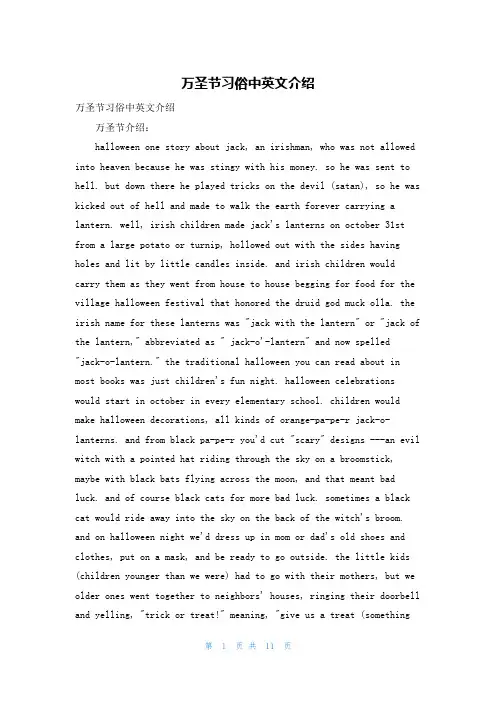
万圣节习俗中英文介绍万圣节习俗中英文介绍万圣节介绍:halloween one story about jack, an irishman, who was not allowed into heaven because he was stingy with his money. so he was sent to hell. but down there he played tricks on the devil (satan), so he was kicked out of hell and made to walk the earth forever carrying a lantern. well, irish children made jack's lanterns on october 31st from a large potato or turnip, hollowed out with the sides having holes and lit by little candles inside. and irish children would carry them as they went from house to house begging for food for the village halloween festival that honored the druid god muck olla. the irish name for these lanterns was "jack with the lantern" or "jack of the lantern," abbreviated as " jack-o'-lantern" and now spelled "jack-o-lantern." the traditional halloween you can read about in most books was just children's fun night. halloween celebrations would start in october in every elementary school. children would make halloween decorations, all kinds of orange-pa-pe-r jack-o-lanterns. and from black pa-pe-r you'd cut "scary" designs ---an evil witch with a pointed hat riding through the sky on a broomstick, maybe with black bats flying across the moon, and that meant bad luck. and of course black cats for more bad luck. sometimes a black cat would ride away into the sky on the back of the witch's broom. and on halloween night we'd dress up in mom or dad's old shoes and clothes, put on a mask, and be ready to go outside. the little kids (children younger than we were) had to go with their mothers, but we older ones went together to neighbors' houses, ringing their doorbell and yelling, "trick or treat!" meaning, "give us a treat (somethingto eat) or we'll play a trick on you!" the people inside were supposed to come to the door and comment on our costumes. oh! here's a ghost. oh, there's a witch. oh, here's an old lady. sometimes they would play along with us and pretend to be scared by some ghost or witch. but they would always have some candy and maybe an apple to put in our "trick or treat bags." but what if no one come to the door, or if someone chased us away? then we'd play a trick on them, usually taking a piece of soap and make marks on their windows. .and afterwards we would go home and count who got the most candy. one popular teen-agers' halloween trick was to unroll a roll of toiletpa-pe-r and throw it high into a tree again and again until the tree was all wrapped in the white pa-pe-r. the pa-pe-r would often stay in the tree for weeks until a heavy snow or rain washed it off. no real harm done, but it made a big mess of both the tree and the yard under it. one kind of halloween mischief.万圣节是西方的鬼节在西方国家,每年的10月31日,有个“halloween”,辞典解释为“the eve of all saints'day”,中文译作:“万圣节之夜”。
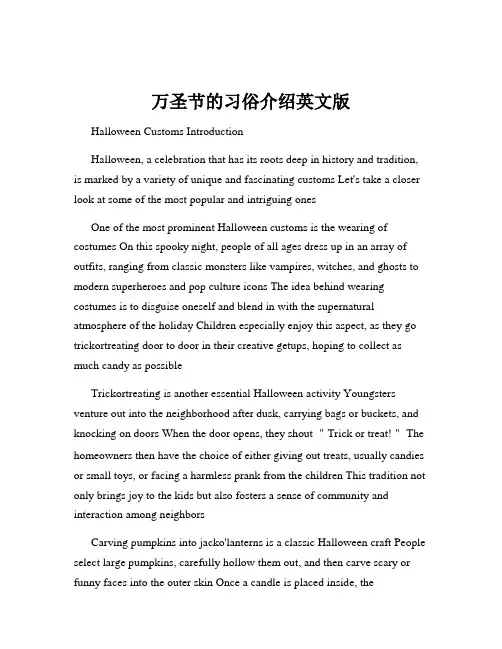
万圣节的习俗介绍英文版Halloween Customs IntroductionHalloween, a celebration that has its roots deep in history and tradition, is marked by a variety of unique and fascinating customs Let's take a closer look at some of the most popular and intriguing onesOne of the most prominent Halloween customs is the wearing of costumes On this spooky night, people of all ages dress up in an array of outfits, ranging from classic monsters like vampires, witches, and ghosts to modern superheroes and pop culture icons The idea behind wearing costumes is to disguise oneself and blend in with the supernatural atmosphere of the holiday Children especially enjoy this aspect, as they go trickortreating door to door in their creative getups, hoping to collect as much candy as possibleTrickortreating is another essential Halloween activity Youngsters venture out into the neighborhood after dusk, carrying bags or buckets, and knocking on doors When the door opens, they shout "Trick or treat!" The homeowners then have the choice of either giving out treats, usually candies or small toys, or facing a harmless prank from the children This tradition not only brings joy to the kids but also fosters a sense of community and interaction among neighborsCarving pumpkins into jacko'lanterns is a classic Halloween craft People select large pumpkins, carefully hollow them out, and then carve scary or funny faces into the outer skin Once a candle is placed inside, theilluminated jacko'lanterns create a spooky and inviting glow on porches and front yards These lanterns are believed to ward off evil spirits and add to the festive ambianceDecorating homes and yards is also a significant part of Halloween People adorn their properties with fake spider webs, creepy crawly props, tombstones, and other spooky decorations Some even go as far as setting up haunted houses or creating elaborate displays to attract visitors and spook passersbyHalloween parties are a common occurrence as well These gatherings often feature spooky music, thematic food and drinks, and games related to the holiday Games like bobbing for apples, where participants try to catch apples floating in a tub of water using only their mouths, are a hit among both kids and adultsAnother interesting custom is telling ghost stories Around a campfire or in a dimly lit room, people share tales of the supernatural, sending shivers down each other's spines This tradition adds an element of mystery and thrill to the nightIn some areas, there are Halloween parades where people showcase their elaborate costumes and march through the streets, creating a lively and festive sceneThe roots of many Halloween customs can be traced back to ancient Celtic and Christian traditions Over time, they have evolved and adapted to modern times, while still retaining their essence of celebration and superstitionHalloween is not just a holiday for scares and sweets; it's a time for creativity, imagination, and coming together to enjoy the fun and excitement of the spooky season Whether it's through costumewearing, trickortreating, or decorating, Halloween offers a unique and memorable experience for allSo, as the night of October 31st approaches, get ready to embrace the spirit of Halloween and partake in these wonderful customs that have been passed down through generations Let the magic and mystery of this special night unfold and create memories that will last a lifetime。
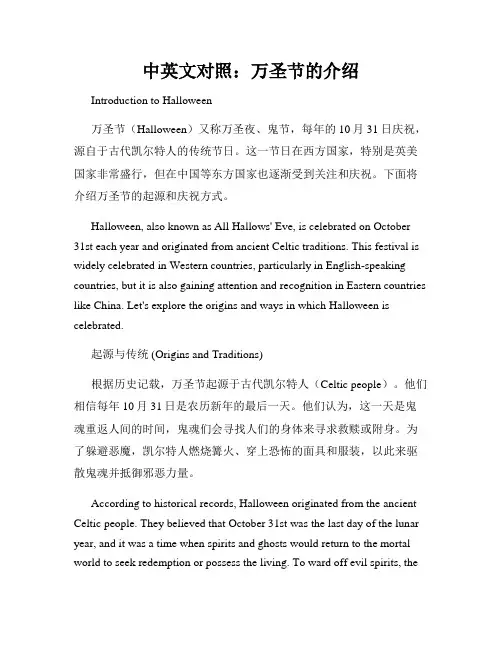
中英文对照:万圣节的介绍Introduction to Halloween万圣节(Halloween)又称万圣夜、鬼节,每年的10月31日庆祝,源自于古代凯尔特人的传统节日。
这一节日在西方国家,特别是英美国家非常盛行,但在中国等东方国家也逐渐受到关注和庆祝。
下面将介绍万圣节的起源和庆祝方式。
Halloween, also known as All Hallows' Eve, is celebrated on October 31st each year and originated from ancient Celtic traditions. This festival is widely celebrated in Western countries, particularly in English-speaking countries, but it is also gaining attention and recognition in Eastern countries like China. Let's explore the origins and ways in which Halloween is celebrated.起源与传统 (Origins and Traditions)根据历史记载,万圣节起源于古代凯尔特人(Celtic people)。
他们相信每年10月31日是农历新年的最后一天。
他们认为,这一天是鬼魂重返人间的时间,鬼魂们会寻找人们的身体来寻求救赎或附身。
为了躲避恶魔,凯尔特人燃烧篝火、穿上恐怖的面具和服装,以此来驱散鬼魂并抵御邪恶力量。
According to historical records, Halloween originated from the ancient Celtic people. They believed that October 31st was the last day of the lunar year, and it was a time when spirits and ghosts would return to the mortal world to seek redemption or possess the living. To ward off evil spirits, theCeltic people would light bonfires, wear frightening masks and costumes, thus dispelling ghosts and resisting evil forces.在中世纪,罗马天主教徒将万圣节(All Hallows' Eve)与万灵节(All Souls' Day)相结合,庆祝这两个节日的时间被称为万圣节季(Hallowmas Season)。
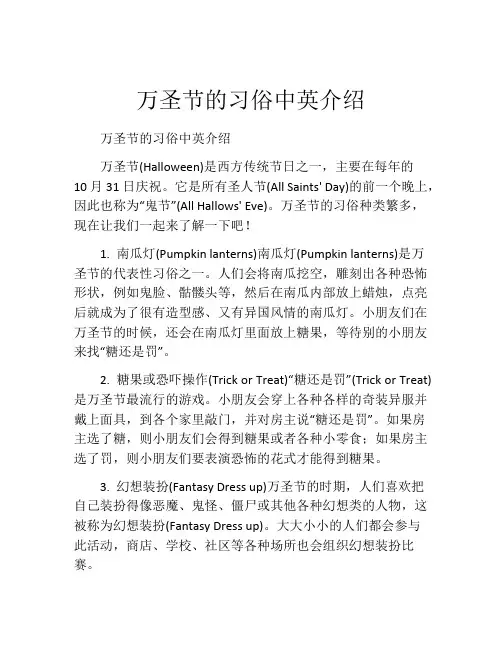
万圣节的习俗中英介绍万圣节的习俗中英介绍万圣节(Halloween)是西方传统节日之一,主要在每年的10月31日庆祝。
它是所有圣人节(All Saints' Day)的前一个晚上,因此也称为“鬼节”(All Hallows' Eve)。
万圣节的习俗种类繁多,现在让我们一起来了解一下吧!1. 南瓜灯(Pumpkin lanterns)南瓜灯(Pumpkin lanterns)是万圣节的代表性习俗之一。
人们会将南瓜挖空,雕刻出各种恐怖形状,例如鬼脸、骷髅头等,然后在南瓜内部放上蜡烛,点亮后就成为了很有造型感、又有异国风情的南瓜灯。
小朋友们在万圣节的时候,还会在南瓜灯里面放上糖果,等待别的小朋友来找“糖还是罚”。
2. 糖果或恐吓操作(Trick or Treat)“糖还是罚”(Trick or Treat)是万圣节最流行的游戏。
小朋友会穿上各种各样的奇装异服并戴上面具,到各个家里敲门,并对房主说“糖还是罚”。
如果房主选了糖,则小朋友们会得到糖果或者各种小零食;如果房主选了罚,则小朋友们要表演恐怖的花式才能得到糖果。
3. 幻想装扮(Fantasy Dress up)万圣节的时期,人们喜欢把自己装扮得像恶魔、鬼怪、僵尸或其他各种幻想类的人物,这被称为幻想装扮(Fantasy Dress up)。
大大小小的人们都会参与此活动,商店、学校、社区等各种场所也会组织幻想装扮比赛。
4. 鬼屋(Haunted house)在万圣节的时候,各种鬼屋(Haunted house)也会出现在城市的各个角落里。
它们被装饰得很吓人,通常有人穿着幻想装扮来“威胁”游客。
有些鬼屋会比较适合小朋友,让他们体验万圣节的恐怖氛围;而其他的鬼屋可能会很恐怖,甚至会造成恐慌。
5. 幸存游戏(Survival game)幸存游戏(Survival game)通常在万圣节的时候举行。
这种游戏通常会在森林或荒野进行,由一些人扮演僵尸,而其他人则要躲避他们,生还到最后。
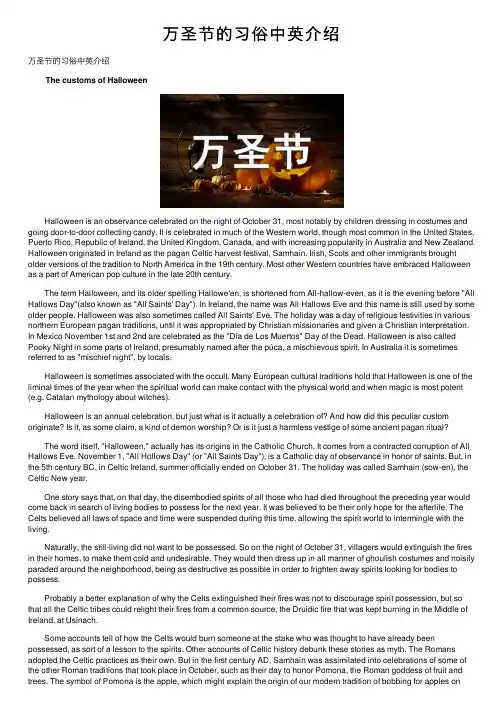
万圣节的习俗中英介绍万圣节的习俗中英介绍 The customs of Halloween Halloween is an observance celebrated on the night of October 31, most notably by children dressing in costumes and going door-to-door collecting candy. It is celebrated in much of the Western world, though most common in the United States, Puerto Rico, Republic of Ireland, the United Kingdom, Canada, and with increasing popularity in Australia and New Zealand. Halloween originated in Ireland as the pagan Celtic harvest festival, Samhain. Irish, Scots and other immigrants brought older versions of the tradition to North America in the 19th century. Most other Western countries have embraced Halloween as a part of American pop culture in the late 20th century. The term Halloween, and its older spelling Hallowe'en, is shortened from All-hallow-even, as it is the evening before "All Hallows Day"(also known as "All Saints' Day"). In Ireland, the name was All Hallows Eve and this name is still used by some older people. Halloween was also sometimes called All Saints' Eve. The holiday was a day of religious festivities in various northern European pagan traditions, until it was appropriated by Christian missionaries and given a Christian interpretation. In Mexico November 1st and 2nd are celebrated as the "Dia de Los Muertos" Day of the Dead. Halloween is also called Pooky Night in some parts of Ireland, presumably named after the púca, a mischievous spirit. In Australia it is sometimes referred to as "mischief night", by locals. Halloween is sometimes associated with the occult. Many European cultural traditions hold that Halloween is one of the liminal times of the year when the spiritual world can make contact with the physical world and when magic is most potent (e.g. Catalan mythology about witches). Halloween is an annual celebration, but just what is it actually a celebration of? And how did this peculiar custom originate? Is it, as some claim, a kind of demon worship? Or is it just a harmless vestige of some ancient pagan ritual? The word itself, "Halloween," actually has its origins in the Catholic Church. It comes from a contracted corruption of All Hallows Eve. November 1, "All Hollows Day" (or "All Saints Day"), is a Catholic day of observance in honor of saints. But, in the 5th century BC, in Celtic Ireland, summer officially ended on October 31. The holiday was called Samhain (sow-en), the Celtic New year. One story says that, on that day, the disembodied spirits of all those who had died throughout the preceding year would come back in search of living bodies to possess for the next year. It was believed to be their only hope for the afterlife. The Celts believed all laws of space and time were suspended during this time, allowing the spirit world to intermingle with the living. Naturally, the still-living did not want to be possessed. So on the night of October 31, villagers would extinguish the fires in their homes, to make them cold and undesirable. They would then dress up in all manner of ghoulish costumes and noisily paraded around the neighborhood, being as destructive as possible in order to frighten away spirits looking for bodies to possess. Probably a better explanation of why the Celts extinguished their fires was not to discourage spirit possession, but so that all the Celtic tribes could relight their fires from a common source, the Druidic fire that was kept burning in the Middle of Ireland, at Usinach. Some accounts tell of how the Celts would burn someone at the stake who was thought to have already been possessed, as sort of a lesson to the spirits. Other accounts of Celtic history debunk these stories as myth. The Romans adopted the Celtic practices as their own. But in the first century AD, Samhain was assimilated into celebrations of some of the other Roman traditions that took place in October, such as their day to honor Pomona, the Roman goddess of fruit and trees. The symbol of Pomona is the apple, which might explain the origin of our modern tradition of bobbing for apples onHalloween. The thrust of the practices also changed over time to become more ritualized. As belief in spirit possession waned, the practice of dressing up like hobgoblins, ghosts, and witches took on a more ceremonial role. The custom of Halloween was brought to America in the 1840's by Irish immigrants fleeing their country's potato famine. At that time, the favorite pranks in New England included tipping over outhouses and unhinging fence gates. The custom of trick-or-treating is thought to have originated not with the Irish Celts, but with a ninth-century European custom called souling. On November 2, All Souls Day, early Christians would walk from village to village begging for "soul cakes," made out of square pieces of bread with currants. The more soul cakes the beggars would receive, the more prayers they would promise to say on behalf of the dead relatives of the donors. At the time, it was believed that the dead remained in limbo for a time after death, and that prayer, even by strangers, could expedite a soul's passage to heaven. The Jack-o-lantern custom probably comes from Irish folklore. As the tale is told, a man named Jack, who was notorious as a drunkard and trickster, tricked Satan into climbing a tree. Jack then carved an image of a cross in the tree's trunk, trapping the devil up the tree. Jack made a deal with the devil that, if he would never tempt him again, he would promise to let him down the tree. According to the folk tale, after Jack died, he was denied entrance to Heaven because of his evil ways, but he was also denied access to Hell because he had tricked the devil. Instead, the devil gave him a single ember to light his way through the frigid darkness. The ember was placed inside a hollowed-out turnip to keep it glowing longer. The Irish used turnips as their "Jack's lanterns" originally. But when the immigrants came to America, they found that pumpkins were far more plentiful than turnips. So the Jack-O-Lantern in America was a hollowed-out pumpkin, lit with an ember. So, although some cults may have adopted Halloween as their favorite "holiday," the day itself did not grow out of evil practices. It grew out of the rituals of Celts celebrating a new year, and out of Medieval prayer rituals of Europeans. And today, even many churches have Halloween parties or pumpkin carving events for the kids. After all, the day itself is only as evil as one cares to make it. 译⽂: 万圣节是纪念庆祝10⽉31⽇晚,尤其是在服饰打扮⼉童和挨家挨户上门收集糖果。
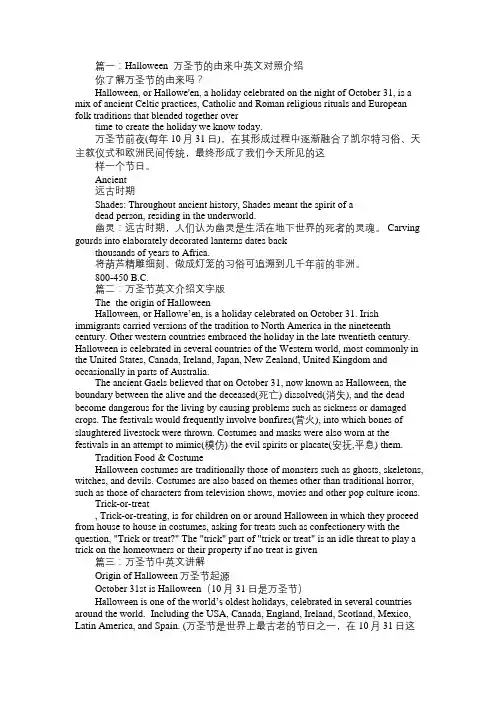
篇一:Halloween_万圣节的由来中英文对照介绍你了解万圣节的由来吗?Halloween, or Hallowe'en, a holiday celebrated on the night of October 31, is a mix of ancient Celtic practices, Catholic and Roman religious rituals and European folk traditions that blended together overtime to create the holiday we know today.万圣节前夜(每年10月31日),在其形成过程中逐渐融合了凯尔特习俗、天主教仪式和欧洲民间传统,最终形成了我们今天所见的这样一个节日。
Ancient远古时期Shades: Throughout ancient history, Shades meant the spirit of adead person, residing in the underworld.幽灵:远古时期,人们认为幽灵是生活在地下世界的死者的灵魂。
Carving gourds into elaborately decorated lanterns dates backthousands of years to Africa.将葫芦精雕细刻、做成灯笼的习俗可追溯到几千年前的非洲。
800-450 B.C.篇二:万圣节英文介绍文字版The the origin of HalloweenHalloween, or Hallowe’en, is a holiday celebrated on October 31. Irish immigrants carried versions of the tradition to North America in the nineteenth century. Other western countries embraced the holiday in the late twentieth century. Halloween is celebrated in several countries of the Western world, most commonly in the United States, Canada, Ireland, Japan, New Zealand, United Kingdom and occasionally in parts of Australia.The ancient Gaels believed that on October 31, now known as Halloween, the boundary between the alive and the deceased(死亡) dissolved(消失), and the dead become dangerous for the living by causing problems such as sickness or damaged crops. The festivals would frequently involve bonfires(营火), into which bones of slaughtered livestock were thrown. Costumes and masks were also worn at the festivals in an attempt to mimic(模仿) the evil spirits or placate(安抚,平息) them.Tradition Food & CostumeHalloween costumes are traditionally those of monsters such as ghosts, skeletons, witches, and devils. Costumes are also based on themes other than traditional horror, such as those of characters from television shows, movies and other pop culture icons.Trick-or-treat, Trick-or-treating, is for children on or around Halloween in which they proceed from house to house in costumes, asking for treats such as confectionery with the question, "Trick or treat?" The "trick" part of "trick or treat" is an idle threat to play a trick on the homeowners or their property if no treat is given篇三:万圣节中英文讲解Origin of Halloween万圣节起源October 31st is Halloween(10月31日是万圣节)Halloween is one of the world’s oldest holidays, celebrated in several countries around the world. Including the USA, Canada, England, Ireland, Scotland, Mexico, Latin America, and Spain. (万圣节是世界上最古老的节日之一,在10月31日这天,有许多国家,如:美国,加拿大,英格兰,爱尔兰,苏格兰,墨西哥,拉丁美洲,西班牙等,都会庆祝万圣节的来临。
万圣节简介中英文万圣节简介中英文在西方国家,每年的10月31日,有个“Halloween”,辞典解释为“The eve of All Saints'Day”,中文译作:“万圣节之夜”。
以下是店铺给大家准备的关于万圣节的中英文介绍,一起来看看吧! Ⅰ:The origin of HalloweenThe legend of the origin of Halloween, there are many versions, the most common view, that is before the birth of Christ from the Medieval Western Europe countries, including Ireland, Scotland and Wales.This person called several of the Medieval Western Europe Druitt people. Druitt in the November 1 New Year, New Year's Eve, young people who set druid team, wearing all kinds of weird mask, carrying a carved radish good light (the late custom pumpkin light system, Medieval Western Europe first there is no pumpkin), they walk in the villages between.This was actually a kind of harvest celebration; also said to be "Halloween", the legend who died that year, the eve of Halloween spirit will visit the world, said that people should be allowed to visit the ghost that the ghost of a successful harvest and to render a hearty welcome. All fire and lights, the one to frighten away the ghost, but also for the ghost light line, to guide their return.Central Europe in the Middle Ages, there had been destroyed by the pagan history of Christianity. However, before the ritual celebration of New Year's Eve never really eliminated, but in the form of witchcraft. This is why we are Halloween, but are also left witches broom, black cat, spells and other marks.一、万圣节的由来关于万圣节由来的传说有许多版本,最普遍的认为,那是源于基督诞生前的古西欧国家,主要包括爱尔兰、苏格兰和威尔士。
竭诚为您提供优质文档/双击可除万圣节的习俗中英文篇一:万圣节中英文讲解originofhalloween万圣节起源october31stishalloween(10月31日是万圣节)halloweenisoneoftheworld’soldestholidays,celebratedinseveralcountriesaroundt heworld.IncludingtheusA,canada,england,Ireland,scot land,mexico,LatinAmerica,andspain.(万圣节是世界上最古老的节日之一,在10月31日这天,有许多国家,如:美国,加拿大,英格兰,爱尔兰,苏格兰,墨西哥,拉丁美洲,西班牙等,都会庆祝万圣节的来临。
)Thecelticpeopleslivedover2,000yearsago.Intheplaceth atisnowIreland,theunitedKingdom,andnorthernFrance.h alloween’soriginsdatebacktotheancientcelticfestivalofsamhain (pronouncedsow-in).(在2000多年前的爱尔兰及法国北部,住着一群凯尔特人,而万圣节就是起源于古凯尔特人的一个叫做samhain的节庆。
)Forthecelticpeoples,thenewYearwascelebratedonnovemb er1stofeveryyear.Thisdatemarkedtheendofsummerandthe beginningofwinter.(凯尔特人选在每年november1st,11月1日庆祝新年,正值夏天结束,冬天刚开始的时节,多半让人联想到黑暗的死亡。
)Traditionsofhalloween万圣节的传统习俗manyofthetraditionsassociatedwithhalloweencanbetrac edbacktotheancientfestivalsofsamhain,suchascostumin g,trick-or-treating,pinata,pumpkincarving.(许多关于halloween的习俗,包括变装打扮,不给糖就捣蛋的游戏,打彩罐的游戏,刻南瓜灯笼等习俗,都可以追溯到凯特尔人samhain节。
万圣节的习俗英文版有中文在西方国家,每年的10月31日,有个“Halloween”,辞典解释为“The eve of All Saints'Day”,中文译作:“万圣节之夜”。
万圣节是西方国家的传统节日。
这一夜是一年中最“闹鬼”的一夜,所以也叫“鬼节”。
西方国家在万圣节里有很多有趣的习俗,下面是店铺整理的万圣节的习俗英文版,欢迎大家阅读!万圣节的习俗英文版介绍一:TINY ghost-like dolls hang from trees, big plastic spiders sit on rooftops and bloody plastic hands reach out from gravestones…Are you ready for the scariest night of the year?树上到处悬挂着鬼怪小玩偶,屋顶盘踞着巨大的塑料蜘蛛,墓穴里伸出一双血淋淋的塑胶手……一年之中最恐怖的夜晚到来了,你好了吗?October 31 is Halloween, one of the most popular festivals in the US, Canada and Britain. The festival began as a day to remember the dead. But nowadays it's all about the carnival atmosphere when people can enjoy dressing up and scaring each other.10月31日万圣节前夜是美国、加拿大和英国最受欢迎的节日。
节日源起于对死者的纪念日。
但现在它完全一场大狂欢,人们尽情享受着改装易容互相恐吓的乐趣。
Halloween is one of children's favourite nights of the year. They dress up as monsters and go to their neighbours'houses. Knocking on the door they shout: "Trick or treat!" Of course, usually people give them "treats" - a like sweets and chocolates. But, if you don't, you can expect a prank such as having your car windows soaped or your garbage cans turned over.万圣节前夜一年之中孩子们最喜欢的夜晚。
万圣节中英文介绍万圣节,这个充满神秘和欢乐的节日,每年的 10 月 31 日都会在世界各地掀起一场独特的狂欢。
对于很多人来说,万圣节是一个可以尽情装扮、搞怪和享受派对的时刻。
万圣节的起源可以追溯到古代凯尔特人的萨温节(Samhain)。
当时的人们认为,在 10 月 31 日这一天,夏天正式结束,冬天开始,同时也是阴阳两界的界限最模糊的时刻,逝者的灵魂会回到人间。
为了驱赶恶灵,他们会点燃篝火,穿上奇异的服装,以保护自己并吓走邪灵。
随着时间的推移,基督教传入欧洲后,11 月 1 日被定为“诸圣节”(All Saints' Day),用来纪念所有的圣徒。
而 10 月 31 日的前夜,也就是我们现在所说的万圣节,逐渐成为了一个融合了各种传统和文化元素的节日。
在英文中,“万圣节”通常被称为“Halloween”。
这个词由“All Hallows' Eve”演变而来,意思是“万圣节前夜”。
在万圣节,装扮是一大特色。
孩子们会穿上各种各样的恐怖或有趣的服装,比如吸血鬼、女巫、鬼魂、僵尸、超级英雄等等。
他们会提着南瓜灯,挨家挨户地敲门,喊着“Trick or treat!”(不给糖就捣蛋!)。
如果主人家给了糖果,孩子们就会开心地离开;如果没有,他们可能就会小小的恶作剧一下。
南瓜灯也是万圣节不可或缺的元素。
通常,人们会把南瓜掏空,雕刻出可怕的面孔,然后在里面放上蜡烛。
夜晚,南瓜灯发出的光芒,为整个节日增添了神秘的氛围。
英文中,南瓜灯被称为“Jacko'lantern”。
除了孩子们的活动,成年人也会举办各种万圣节派对。
派对上,人们会精心装扮自己,场地也会布置得充满恐怖和神秘的气息。
会有各种恐怖的道具、蜘蛛网、蝙蝠等等。
万圣节的美食也很有特色。
有糖果玉米(Candy Corn),这种小小的三角形糖果,颜色鲜艳,非常受孩子们欢迎。
还有用巧克力做成的蝙蝠形状的巧克力、眼球形状的糖果等等。
在一些地区,还会有万圣节游行活动。
万圣节风俗英文介绍万圣节风俗英文介绍万圣节是西方传统节日,时间为每年的10月31日夜晚,又称“鬼怪夜”和“鬼怪节”。
因鬼怪节的'第二天是西方世界的万圣节(或圣人节),故鬼怪之夜便被称为万圣节前夜。
那么万圣节有哪些习俗呢?下面就让店铺来跟大家介绍一下吧!【万圣节习俗介绍英文版】Children in costumes race from house to house asking for treats. A carved pumpkin, called a jack-o’-lantern, grins from a porch as the children pass. According to legend, jack-o’-lanterns protect people in their homes from ghostly spirits.It’s all part of the fun on Halloween! The roots of Hall oween stretch back thousands of years and borrow customs from several parts of the world.WHAT IS HALLOWEEN?Halloween is a holiday celebrated on October 31. By tradition, Halloween begins after sunset. Long ago, people believed that witches gathered together and ghosts roamed the world on Halloween. Today, most people no longer believe in ghosts and witches. But these supernatural beings are still a part of Halloween.The colors black and orange are also a part of Halloween. Black is a symbol for night and orange is the color of pumpkins.A jack-o’-lantern is a hollowed-out pumpkin with a face carved on one side. Candles are usually placed inside, giving the face a spooky glow.DRESSING IN COSTUMESDressing in masks and costumes is a popular Halloween activ ity. Costumes can be traditional and scary, such as a witch’spointy hat and black gown. Costumes may also have a modern flavor. Many children dress up as movie characters or a favorite superhero.But Halloween is not just for children. Many adults enjoy showing off their costumes at Halloween parties!TRICK-OR-TREATINGOnce in costume, children go from house to house saying “Trick or treat!” In the past, children might play a “trick” on people who did not give treats. They might pelt houses with eggs or ol d tomatoes, or play other pranks. Today, children’s cries of “Trick or treat!” are usually rewarded with candy.HOW HALLOWEEN GOT STARTEDOne of the oldest Halloween traditions comes from the ancient Celts, who lived in western and central Europe long ago. The Celts celebrated a holidayy called Samhain on October 31. After sunset that day, people believed that spirits of the dead would rise and walk the earth. The Celts made offerings of food and drink to keep the spirits away.Beginning about 2,000 years ago, the Roman Empire conquered many Celtic peoples. But Celtic traditions, including Samhain, remained strong in areas such as Ireland and Scotland, even after the Roman conquest.The Roman Catholic Church tried to replace Samhain in 835 with All Saints’ Day, a day to honor saints of the Church. The eve of All Saints’ Day is October 31. It is called Allhallows or Hallowmas by the Church.HOW DID HALLOWEEN COME TO AMERICA?Halloween first came to America with early settlers from Celtic areas in Europe, such as Ireland and Scotland. But otherAmerican settlers with strict religious beliefs, including the Puritans from England, rejected Halloween. The arrival of many Irish immigrants during the 1800s helped spread Halloween’s popularity.But by the late 1800s, fewer people believed in ancient superstitions of ghosts and witches. Halloween became more a holiday for children to receive treats and dress in costume.下载全文。
万圣节是几月几日英文_万圣节的习俗英文万圣节的习俗介绍英汉两版导读:在这个国际化社会,了解一项节日不能只懂得从中文版入手,还要学会英语版,不然当你要为外国小朋友介绍时,或者需要英文写作时,你就会变得无从下手。
那么万圣节的习俗英文怎么说呢?为了更进一步让你了解英文版的万圣节习俗说法,以下是万年历小编带来的万圣节的习俗介绍英汉两版,快点来看看吧。
万圣节的习俗英文万圣节的习俗介绍英汉两版万圣节的习俗英文万圣节的习俗介绍英汉两版南瓜灯Jack-o’-lanternFamiliesinBritainbuypumpkinsinstoresandsupermarketseveryHalloweento carveJack-o’-lanterns.Thepumpkinsaretransformedintospookyfacesandarelitupbycandl esplacedinside.Theoriginofthispracticehasmanyversions,mostofwhichrevo lvearoundamancalled‘StingyJack’whoroamstheearthaimlesslycarryingapumpkinlanternbecauseofhisillnatur e.每值万圣节,英国各家各户会从商店或超市买来南瓜刻灯。
这些南瓜经过雕刻会转变成一张张阴森可怕的脸,掏空心的南瓜里面可以放上蜡烛,从而变成“南瓜灯”。
刻南瓜灯这一习俗的起源有很多版本,不过大多数都和一个叫“小气鬼杰克”的人有关,性格怪僻的他总是漫无目的地提着南瓜等走来走去。
咬苹果ApplebobbingHaveyoureadAgathaChristie’sdetectivenovelHallowe’enParty?Ifso,youmightknowthispopularHalloweenactivitycalled‘applebobbing’.Inthegame,competitorscatchappleswiththeirteethfroma largebucketorbasinofwater.Whoevercatchesthefirstapplewins.你读过阿加莎·克里斯蒂的侦探小说《万圣节前的谋杀案》吗?如果你曾经读过,那么可能会知道“咬苹果”这个很受欢迎的万圣节活动。
万圣节的习俗(中英文版)
TINY ghost-like dolls hang from trees, big plastic spiders sit on rooftops and bloody plastic hands reach out from gravestones…Are you ready for the scariest night of the year?
树上到处悬挂着鬼怪小玩偶,屋顶盘踞着巨大的塑料蜘蛛,墓穴里伸出一双血淋淋的塑胶手……一年之中最恐怖的夜晚到来了,你好了吗?
October 31 is Halloween, one of the most popular festivals in the US, Canada and Britain. The festival began as a day to remember the dead. But nowadays it's all about the carnival atmosphere when people can enjoy dressing up and scaring each other.
10月31日万圣节前夜是美国、加拿大和英国最受欢迎的节日。
节日源起于对死者的纪念日。
但现在它完全一场大狂欢,人们尽情享受着改装易容互相恐吓的乐趣。
Halloween is one of children's favourite nights of the year. They dress up as monsters and go
to their neighbors' houses. Knocking on the door they shout: "Trick or treat!" Of course, usually people give them "treats" - a like sweets and chocolates. But, if you don't, you can expect a prank such as having your car windows soaped or your garbage cans turned over.
万圣节前夜一年之中孩子们最喜欢的夜晚。
打扮成妖怪去邻居家,敲着门大喊:“不给糖就捣蛋!”当然,人们通常会给“糖”——比如甜食或者巧克力。
但你不给,那就等着一场恶作剧吧,你会你的车窗被涂上了肥皂,垃圾桶翻倒在地,等等。
Halloween is also a time for masquerade parties. Witches fly in on broomsticks, while ghosts and skeletons chat on the dance floor.
万圣节前夜举办化妆舞会的好时机。
你会看到女巫坐着扫帚柄飞进来,鬼怪和骷髅则在舞池中窃窃私语。
You can even dress up as a famous monster like Dracula! The motto is: "The scarier, the better."
你还可以化妆成像吸血鬼那样可怕的妖怪。
有句谚语说:“越恐怖越好。
”
Even making Halloween food should be like casting a spell or mixing a magic drink. In Britain, people drink "Witch's Mix", made with apple, orange, grape and berry juice. Children also enjoy "Halloween Worms," made from egg noodles. And how do you like the sound of "Eye-Balls"?
Don't worry, they're made with scoops of chocolate and vanilla ice cream, shaped like human eyes. Skeleton-shaped cookies are equally popular.
甚至连万圣节前夜做的食物也要像下了咒语或者配备魔法饮料。
在英国,人们喝叫“巫师之饮”的东西,用苹果、橘子、葡萄和浆果的汁调配而成。
孩子们还喜欢吃“万圣节虫子”,是
用鸡蛋面做的。
你觉得“眼珠子”听上去怎么样?别担心,那只是用几勺巧克力和香草冰激凌做的,只不过像是人眼的形状。
头盖骨形状的饼干同样也很受欢迎。
A well-known Halloween tradition is to make lanterns from pumpkins, called
"Jack-o-lanterns". First, the inside of the pumpkin is removed. Then, a face is cut into the pumpkin, traditionally a smiling, devil face. Finally a candle is placed inside, and the lantern is put at the front of the house to keep evil spirits away.
万圣节前夜的众所周知的传统用南瓜做成灯,叫“杰克灯”。
,把南瓜里面掏空。
然后在南瓜上切出一张脸孔,通常是一张笑眯眯的魔鬼面孔。
最后,在里面放上一只蜡烛,然后把南瓜灯房子前面用来吓跑那些邪恶的幽灵。
Besides pumpkin cutting, "apple-bobbing" is another popular game. Several apples are put floating in water in a big bucket. Children have their hands tied behind their backs. They have to try to pick the apples out of the water using only their mouths. Of course, people get very wet and it is very funny to watch.
除了切南瓜,“叼苹果”很流行的游戏。
把几只苹果大水桶里面飘浮着。
孩子们的手被绑在背后。
只能用嘴巴把苹果从水里叼。
当然了,人们会全都湿淋淋的,光看着就很有趣。